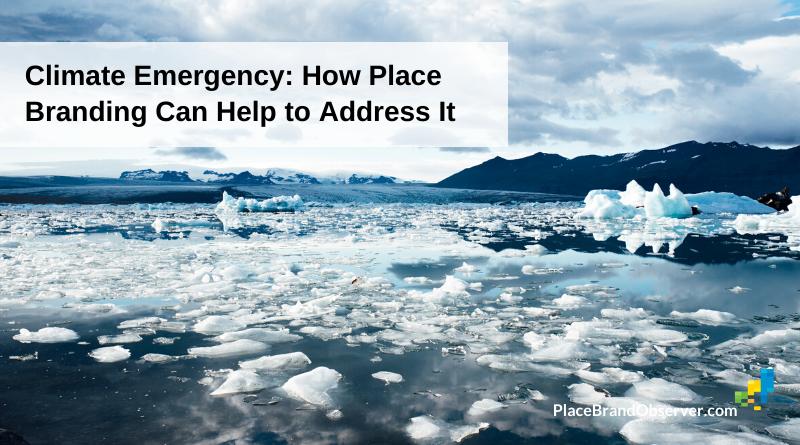A thriving economy, robust infrastructure, strong cultural identity, and general attractiveness used to be the factors for choosing a place to invest, study, live or work. But with climate change taking up speed, place branding experts are returning to the drawing boards to include the climate emergency into city- and country brand strategies.
But how exactly can place branding help to address the climate emergency? And how is it affected by it? We asked our panel of place branding specialists (in alphabetical order, with those available for consulting, research or as speakers featured upfront).
Our key takeaways:
- Having a strong place brand in a competitive world is important, but what differentiates a city/country from the rest nowadays is its resolve to ensure sustainability, including addressing the climate emergency.
- Many big names in the corporate world have long made bold climate commitments. Expectations are growing to see similar commitments made by communities and places.
- Investors, visitors and residents are attracted to those cities that have a thriving economy, good living conditions, and a ‘smarter’ and ‘cleaner’ environment. Cities with a progressive climate image, like Copenhagen, will benefit.
- Place branding in 2020 is at a juncture where values around sustainability are becoming more important. Cities, regions and countries not including the climate crisis and other sustainability concerns in their strategic brand positioning might find their reputation and competitiveness threatened.
- Greenwashing is no longer an option as it’s being called out by well-informed citizens and stakeholders. Walk the talk.
- Place branding is all about mobilizing diverse stakeholders, which is also critical to addressing the climate emergency.
New: Download our white paper on place branding and the climate emergency!
Bill Baker
A majority of places, organizations and individuals seek to be considered “good global citizens.” As do an increasing number of prospective visitors, residents, and investors. In the future, the level to which locations are supportive and active in addressing the climate emergency will be of increasing importance.
The science and policies directed toward addressing climate change are going to be dynamic with many advances and changes. It’s likely that the efforts and techniques in addressing these issues will also be common to competitor locations. Some will be local, others national and international. Place brand positioning relies on differentiating factors and points of difference. It’s possible that basing brand positioning on climate-related initiatives alone will not provide the sustainable points of difference required for successful branding because they may be easily matched by others.
While climate change initiatives may not be central to a brand, they may be essential to brand management and brand partnerships. It may be necessary for organizations responsible for the sustainability of the local environment, construction and government policy to be closely tied to the brand strategy. For example, locations with coral reefs will need to be closely integrated with the organizations responsible for the policies related to the health of the reef.
Ed Burghard
Climate has a direct impact on the quality of the resident’s lives. As a consequence, it is one of the pillar factors that need to be considered in a location’s initiative choices around placemaking.
Most community leaders recognize the need to understand the environmental impact of decisions, but undoubtedly more can be done to better articulate both the short- and long-term effect.
For example, communities that experience a boom/bust cycle (for whatever reason) often fail to think through the impact of decisions that fueled the boom on their public health services. They run forward and then realize significantly more investment is needed to ensure clean water and air for their residents. Better local decision-making that protects the environment will help.
In addition, strategies to educate residents on facts regarding the climate would be useful. How many people understand the potential that planting more trees has to reduce carbon emissions?
In contrast, doomsday hyperbole is rarely helpful. Education drives better decision-making in almost every case.
Efe Sevin
I’d recommend two overall place branding strategies to address the climate emergency:
- Climate change is going to affect places differently – while some countries or cities will face imminent existential threats, others will see imposed changes in lifestyles, for instance. Each and every place should acknowledge the impacts they will face. They should engage with local, regional, and global stakeholders to contribute to the overall discussions we are having.
- Place branding is a strategic narrative in itself. Combating climate change should become a part of this narrative – communicated not only through words and images, but also through actions. Places should adopt policies to mitigate the impacts of global warming. The issue is not one that should be left only to state governments or even to large cities. From the C40 Cities Climate Leadership Group to ICLEI – Local Governments for Sustainability, places of any size have numerous platforms to get their voices heard and to influence international policies.
Heather Skinner
Firstly, climate change issues must be included in a place brand strategy, and this is rarely the case. Secondly, place brand strategies should possibly have less of a focus on economic growth as the be-all and end-all and instead, consider focusing more on issues of sufficiency and sustainability.
Hjörtur Smárason
Scope Communications / Speaker
This is an interesting question. It depends on your current status. There are two important aspects to this.
The first one is the ability to attract the right investment. Companies today want to be able to portrait a responsible climate image, which means that they are much more likely to invest in a city or country that has a progressive climate image, such as Copenhagen or the Netherlands.
If you have the image of a climate slug, investment is much more likely to stay away. This is particularly tricky for places that rely heavily on fossil fuels for their economy. If they want to survive the upcoming energy transition without a severely damaged economy, they need to think about changing their image from an oil economy to whatever they want to be the replacement economy. Masdar City in Abu Dhabi is an example of a great effort in that direction, and so are initiatives such as the Museum of the Future in Dubai.
The second aspect is export. The value of origin. With the changes that have started, there will be a great demand for new green, climate-friendly solutions. Cities around the world will know where to find these solutions – and it will be in the cities with the most positive climate image. Again, Copenhagen has been focusing on this strategically with the aim of building a fast-growing climate-friendly export industry. Blox-Hub is a center in Copenhagen for companies that specialize in different fields of green, sustainable urban development.
In every region, there are opportunities for cities to become the regional hub, if not an international hub, for climate-friendly solutions.
Jeannette Hanna
Trajectory Brand Consultants / Speaker profile
As Malcolm Allan argues, the climate crisis stance of places is fast becoming a critical differentiator. In the corporate world, over 1,140 leading companies – including Alphabet, Microsoft, Sony, Unilever, and Apple – have already made bold climate commitments. They’ll expect similar promises from the communities in which they operate.
Places that invested in green technologies some time ago are well-positioned for the future. One Canadian example is Sault Ste Marie, Ontario. This city of 73,300, until recently, suffered all the typical challenges of a former industrial center that morphed into a “rust belt” town. In the 19th Century, SSM was an early innovator in hydroelectric energy.
As part of its brand strategy, the city embraced energy innovation as a central pillar of its positioning, backed by its commitment to wind, solar, hydro and geothermal technologies. Today, the area is a net exporter of energy and produces 1.6 times its needs in 100% renewable electricity. It’s a compelling attractor for many types of businesses!
Joao Freire
Place branding strategies can become an engine to address the climate emergency. If a brand revisits its purpose and includes the climate emergency in its mission and vision, it will then be possible to mobilize all of the different stakeholders that are part of the brand. In this way, place branding strategies can be a trigger that unites stakeholders to act on climate change.
Juan Carlos Belloso
I think climate change and sustainability are a must for all places and destinations (cities, regions, countries). Being aware of the climate emergency and putting sustainability in the center of any place branding strategy will be key to succeed and to stay relevant today and in the future: especially if we think about our future generations; it is a responsibility for all of us to leave them a better world.
I believe, compromise with climate emergency and sustainability will be key decision criteria for people when considering where to go on vacation, where to live, study, work, invest or set up a company. So it is clear that any place brand strategy should embrace sustainability as a key element and also as a tool that can help to raise awareness among citizens and the population in general, to address the climate emergency.
Magdalena Florek
In the world, as we know it, climate emergency issues should become a mandatory element of place branding strategies. They should be linked to specific place brand values and should even extend them, as well as putting them into visible and effective actions.
Embracing climate-friendly measures, like promoting public transport or recycling, will always be perceived as positive; consequently, there is no risk involved and it is a win-win situation. Some places started building strategies based solely on sustainable development (including the climate change challenges). If it is at the centre of their branding, they need strong legitimacy, support, and consistency.
For many groups (especially the young generation), the climate emergency response of places would be among the main criteria of place evaluation and would set the direction of their behaviour.
Most importantly, though, the crucial thing is for place managers to recognize that the climate emergency is a topic of importance to place brands.
Malcolm Allan
Since my recent blog on this topic was published by the Place Brand Observer on 27 December 2019, I have been in conversation about it with fellow practitioners in this field. A number of important issues stand out from these conversations:
- the difficulties that place brand strategists face when their politicians or senior public officials are, at worst, climate change deniers and unwilling to invest in, or discourage others to, measures to address the crisis;
- the fear that some public administrations have that in publicising what they are beginning to do, to tackle the climate emergency as a key element of their brand strategy and offer signals that their country, region, city or place has significant climate change-induced problems and that publicising such actions will deter investment and cause a flight of capital and people;
- that place branding should concentrate on developing offers that are positive, attractive and tell stories that induce happiness.
For me, these issues are all part and parcel of the denial, risk-averse, and fear responses of the political classes and senior corporate executives, to the evidence others can plainly see.
Places taking no or minimal action to address the climate emergency will face the tough question from intelligent investors and people – what are you doing to address it? If the answer is nothing or action that is the equivalent of “greenwash”, then, in my opinion, their brand will be viewed as damaged goods.
Robert Govers
Independent advisor / Speaker / Researcher
You might have noticed that – in my book – I’ve argued extensively that if places want to build reputation they need to show – in imaginative ways – their sense of community, identity, and virtue; that is, show – in original, creative and inspiring ways – that a place is capable of doing what’s right. This, obviously, includes battling climate change, but many other global challenges besides (see for instance the Good Country Index).
So, at a policy-level, I certainly agree that the climate emergency should be addressed in some way in place branding strategies, and it would be good to take it up a notch, to show clients that it is in their own interest to care.
Sebastian Zenker
Some places defined climate topics as part of their brand (for example Copenhagen with its aim to be a carbon-oxygen neutral city). Having this strategic agreement within the city urges the policies to be developed into this direction, and it is creating awareness for these topics within and outside of the place.
Todd Babiak
Place branding can help address the climate emergency by being honest, and by working with the politicians and other leaders to implement measures that might be very difficult to sell. Humans think in the short-term, and so much of what we have to do involves sacrifice.
If we can help, in a culturally-specific way, to sell “our best selves” to each other, I think climate can be an important consideration in our work. It’s certainly a key element of placemaking in cities. The best thinking, in urban design, happens to address the climate emergency. But people do love their cars…
Tom Buncle
Yellow Railroad Consulting / Speaker profile
Tough question. It should perhaps be the other way round: “How can places address the climate emergency? How might their commitment to doing so affect their brand image?”
Climate change is the greatest challenge we face. Nevertheless, people will still travel. So, places should focus on attracting those whose environmental impact will be lowest and whose contribution to the community will be greatest. This means proper destination management planning, minimizing visitor impact, and developing visitor experiences that encourage responsible behaviour.
There is something distasteful about using a brand to demonstrate ‘good citizenship’ in relation to climate change. This should be a given and universally expected, to the extent that such good behaviour should be unremarkable.
Visitors will increasingly expect the destinations they visit to be demonstrably sustainable. Hopefully, before long, places will stand out if they don’t offer a sustainable experience, and consequently slip down the holiday rankings… That’s progress!
Adam Mikołajczyk
Climate change and adapting cities to these changes is a hot topic being discussed in almost all cities today. I can’t imagine this topic being ignored in place branding strategies. In practice, I see at least two levels of adapting the topic of climate change and environmental protection:
- Incorporation of above-average care for the environment and climate into the brand’s identity, thus creating a specific competitive advantage (e.g. in the fight for new residents).
- The second issue is, of course, communication tactics, including public diplomacy activities.
Andrea Lucarelli
Not sure place branding can be used to address the climate emergency. Of course, if we think about place branding as a broader term, strategies of, for example, de-marketing can help to solve some acute problems of specific places. But I am skeptical about its possible impact on a global scale.
Aparna Sharma
Countries and cities can no longer afford to or even ignore climate emergencies whilst articulating their place branding strategies. In fact, given our existence being inextricably linked with climate emergencies, place branding strategies should effectively use this as an opportunity to both create awareness of the efforts and initiatives being made in this direction, as well as to reiterate the call for action for international cooperation. This is the new determinant and measure that should find its way into surveys on place branding, to the extent to which it defines responsible living.
Cecilia Cassinger
There is great, but currently unrealized, potential for place branding strategies to take a lead in making countries and cities environmentally sustainable. The main challenge is to reformulate the neo-liberal growth agenda behind place branding in a direction that will support green initiatives and transition.
The branding of places needs to start from the needs and interests of local communities, rather than corporations. I think it is useful to understand place branding as a form of aspirational talk that does not primarily represent the place as it is in the present moment, but sets a future vision for what it could become, which can inspire and push climate change action.
Cecilia Pasquinelli
As brands are committed to impact and can change consumer behaviour, I think country and city brands may play a role in boosting awareness, concern, and care for climate change, as well as other social and environmental issues. I think this is especially true as cities and countries, meaning their communities, stand for lifestyle values: a city/country brand points to those values that a local community may collectively decide to engage with.
Although stereotypes are certainly part of this, through the place experience concrete examples are provided. The challenge of place branding is to effectively boost a cultural mindset that, by educating and inspiring, contributes to positive relations with the branded place (e.g., residents, visitors, policy-makers choosing and showing responsible behaviour) and opens to universal concern for climate change with a local interpretative key.
In this regard, the pairing of place branding and cause marketing would be worthy of attention and further experimentation.
Eduardo Oliveira
Studies outline that green infrastructures (urban forests, green leisure areas, lakes, natural habitats in cities) are vital. First, they play a key role in attracting businesses and people and provide a ground for recreational and outdoor industries to develop. Secondly, neglected green infrastructures affect a place’s image and consequently hinder branding efforts for attracting investment and ensuring residential attractiveness.
Three possible domains link place branding and green infrastructures:
- economic – investing in green infrastructures with the income generated through branding.
- communication – using branding to raise awareness for the preservation of green infrastructures in cities.
- policy integration – using the advantages of preserved green infrastructures in place branding strategies, as those support a place’s attractiveness.
Gary Warnaby
The climate emergency is a ‘clear and present danger’ to the planet as a whole, and inevitably to some places in particular, by virtue of their increased susceptibility to disruption because of climatic conditions or rising sea levels, etc. arising from their location.
Location (especially in terms of comparative locational advantage) has been a long-standing trope of place marketing and branding messages. Perhaps going forward, the emphasis of such messages may place more emphasis on locational resilience?
Moreover, not engaging with – or indeed, ignoring, or even worse, denying the existence of – the climate emergency has the potential for significant reputational damage for those places that adopt such a position.
Hila Oren
Firstly, it is important to acknowledge that environmental and climate issues are complex and global, and the ability of a single country or city to address these challenges is limited.
However, this question goes to the core of branding: a brand is not about logos and slogans but about how you actualize and live values. Therefore, any city or country which seeks to improve the quality of life for its residents or citizens must ‘walk the talk’ and include measures which create a greener, cleaner and safer environment for all.
Hong Fan
I think countries have more to say in this area. Countries and cities, first of all, can address the climate emergency and have a distinctive approach to their advocacy and action in how to deal with it.
Secondly, citizens of the countries and the cities can have a special day or/and special event to express their concern about this global issue.
Third, the leaders of the countries and the cities should speak out their concern on this issue and shout loud on the global stage.
Inga Hlin
Places have a great opportunity to address the climate emergency through their place branding strategies. Place branding is about involving both public and private sector and what better opportunity is there than through a joint strategy for the place e.g. planning, living, travel, invest and trade.
In this sense, integrating relevant UN Sustainable Development Goals into the strategies is vital both for branding, development and being a citizen in the world today. Cities and countries should plan actions and implementations, such as in relation to clean energy, carbon footprint, responsible consumption, recycling, and the industries and infrastructure that are relevant to the place and its brand.
Travelers, citizens, and investors want to be responsible and sustainable in their actions. For example, in Iceland the tourism industry has been encouraging less plastic use and responsible travel behavior through the destination branding under the umbrella brand of ‘Inspired by Iceland’.
Jeremy Tamanini
The 2020s are all about tangible, measurable action in addressing the climate emergency. The 2010s saw how “greenwashing” got called out, with all stakeholders now being accountable to a thorough review of just how green their operations, energy use, resource efficiency, supply chain etc. really are. The days are over of printing your annual report on recycled paper to show how “green” you are as a company. Place branding strategies must internalize this fact, to be viewed as credible.
Beyond that, successful place branding strategies often mobilize diverse stakeholders and this is something critical to addressing the climate emergency. Place branding strategies that focus on specific actions that tangibly reduce environmental footprint are also interesting.
Jordi de San Eugenio Vela
For our present and our future, it’s critical to add climate emergency as one of the main drivers of our place branding campaigns. We should contribute to the preservation of the environment and our strategies on place branding need to put their main focus on the contribution in awareness and respect to the environment – as the main claim to get better and healthier places to live, visit or invest in.
José Pablo Arango
Place branding teams can run campaigns to mobilize citizens to change customs and bad habits that affect the sustainability of the place. This might achieve important changes that will be reflected not only in their place’s future but in its perception.
Marta Hereźniak
Countries and cities are powerful international actors that are able to address climate emergencies. Climate issues can only be resolved through a cooperative approach, one where traditionally understood notions of individual competitiveness, cost-effectiveness, national interest, and pride will need to be redefined.
Achieving this means that city and country leaders must inspire various stakeholders: businesses, citizens, the educational sector, media, NGOs and foreign partners, to develop and advocate sustainable public policies in diverse areas.
To do this effectively, however, places must be seen as fit to pursue such an agenda. Here is where place branding strategies can help: through effective branding, a place can define itself as dedicated to climate issues and can be seen as such by the international community. Consequently, such places are perceived as legitimate to set and pursue the pro-climate agenda, create networks and partnerships and to develop sustainable educational, social and economic policies.
Rebecca Smith
If your country or city is authentically oriented toward valuing the environment and addressing the impacts of climate change, then the climate emergency provides a catalyst to drive the initiatives, policies, and initiatives you want to deliver. If it’s not a core part of your proposition or value set, then the climate emergency is likely to create some significant discomfort in your city or country, and it will take more than smart branding to resolve that gap.
Sonya Hanna
As brands are increasingly being held accountable and put under pressure by consumers to address environmental challenges, the argument for the inclusion of actions to address climate change in place branding strategies has validity. Places that are – or aspiring to become – economically and socially more vibrant must consider infrastructural regeneration towards a ‘smarter’ and ‘cleaner’ environment.
But challenges do exist. While at the national and even international level legislation is driving a move towards renewable energy and the use of biodegradables, at a more local level there is limited access to resources. Communities, schools, and local businesses, for example, are in high competition with the more (potentially) pressing needs of local residents.
As such, there exists a need for the integration of place branding strategies that strive to attract more visitors, leading to potentially more residents and investment, i.e. place consumers, with the ongoing sectoral development strategies of places.
Previous questions answered by the panel here.
You’d like to ask the panel a question? Get in touch!
Enjoyed this summary of expert views on why it is important to include the climate emergency in place branding initiatives – and how to do it? Thanks for sharing!
















